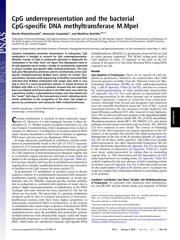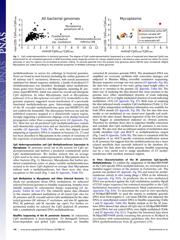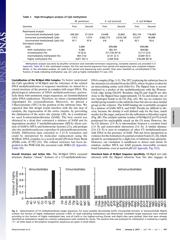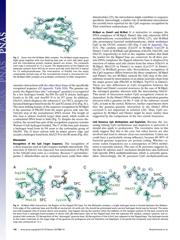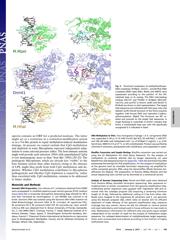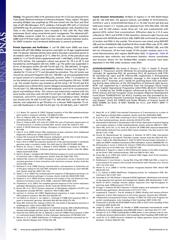Datasheet 搜索 > 运算放大器 > TI(德州仪器) > VFC320CPG4 数据手册 > VFC320CPG4 其他数据使用手册 1/6 页
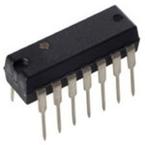
¥ 223.776
VFC320CPG4 其他数据使用手册 - TI(德州仪器)
制造商:
TI(德州仪器)
分类:
运算放大器
封装:
PDIP-14
描述:
1MHz 时线性误差为 0.1% 的压频和频压转换器 14-PDIP -25 to 85
Pictures:
3D模型
符号图
焊盘图
引脚图
产品图
VFC320CPG4数据手册
Page:
of 6 Go
若手册格式错乱,请下载阅览PDF原文件

CpG underrepresentation and the bacterial
CpG-specific DNA methyltransferase M.MpeI
Marek Wojciechowski
a
, Honorata Czapinska
a
, and Matthias Bochtler
a,b,c,1
a
Laboratory of Structural Biology, International Institute of Molecular and Cell Biology, 02-109, Warsaw, Poland;
b
Institute of Biochemistry and Biophysics of
the Polish Academy of Sciences, 02-106, Warsaw, Poland; and
c
Laboratory of Structural Biology, Schools of Chemistry and Biosciences, Cardiff University,
Cardiff CF10 3AT, United Kingdom
Edited* by Robert Huber, Max Planck Institute of Chemistry, Planegg-Martinsried, Germany, and approved November 19, 2012 (received for review May 11, 2012)
Cytosine methylation promotes deamination. In eukaryotes, CpG
methylation is thought to account for CpG underrepresentation.
Whether scarcity of CpGs in prokaryotic genomes is diagnostic for
methylation is not clear. Here, we report that Mycoplasms tend to
be CpG depleted and to harbor a family of constitutively expressed
or phase variable CpG-specific DNA methyltransferases. The very
CpG poor Mycoplasma penetrans and its constitutively active CpG-
specific methyltransferase M.MpeI were chosen for further char-
acterization. Genome-wide sequencing of bisulfite-converted DNA
indicated that M.MpeI methylated CpG target sites both in vivo
and in vitro in a locus-nonselective manner. A crystal structure of
M.MpeI with DNA at 2.15-Å resolution showed that the substrate
base was flipped and that its place in the DNA stack was taken by
a glutamine residue. A phenylalanine residue was intercalated into
the “weak” CpG step of the nonsubstrate strand, indicating mech-
anistic similarities in the recognition of the short CpG target se-
quence by prokaryotic and eukaryotic DNA methyltransferases.
bisulfite sequencing
|
cytosine deamination
|
genome evolution
|
microbiology
|
structural biology
C
ytosine methylation is essential in m any eukaryo tic organ-
isms (1). However, it is also mutagenic, because it drives de-
amination (2, 3). Methyl transfer promotes hydrolysis (2), and
once formed, 5-methylcytosine (5mC) deaminates twice as fast as
cytosine (3). Moreover, 5-methylation of cytosines subverts DNA
repair, because deamination of 5mC leads to thymine (a legitimate
DNA base) and not uracil (an illegitimate DNA base).
In many eukaryotes, particularly in vertebrates, cytosine meth-
ylation is predominan tly found in the CpG (5′-C G-3′)sequence
context (4, 5). Consistent with methylation-driven l oss, the CpG
din u c l eo ti de is strongly underrepresented in vertebrate genomes
(6). CpG depletion is most pronounced in intergenic regions, less
so in promoter regions and introns, and least in exons, which are
subject to the strongest selective pressure (SI Appendix, Table S1).
It is not clear whether CpG loss due to methylation in mammals is
ongoing (6) or whether equilibrium between loss and restoration
of cytosines in the CpG context has been reached (7).
In prokaryotes, C5 methylation of cytosines occurs in diverse
sequence contexts. It is predominantly associated with restriction-
modification systems, targeting short palindromic or nearly pal-
indromic sites (8). Whether sequence-specific cytosine methyla-
tion in prokaryotes is correlated with depletion of target sites is
unclear. Slight underrepresentation of palindromes in the DNA
of phages and some bacteria has been reported (9, 10), but the
effects are very weak. The (near) lack of a genomic methylation
footprint could be d ue to transient association of restriction-
modification systems with their ho sts, higher proportion of
functionally constrained DNA in prokaryotes, or the scarcity
of methylation sites (most target sequences of prokaryotic DNA
methyltransferases are at least four nucleotides long). The latter
explanation leaves open the possibility that prokaryotic cytosine
methyltransferases with dinucleotide targets could still shape
dinucleotide frequencies in host genomes. Spiroplasma monobiae
MQ1, which hosts the well-known bacterial CpG-specificDNA
methyltransferase (M.SssI), is a proprietary strain and has not had
its entire genome sequenced. The M.SssI coding gene itself is
CpG depleted (5 CpGs, 23 expected on the basis of the GC
content of the gene) (11), but some ribosomal RNA coding DNA
sequences are not.
Results
CpG Depletion in Prokaryotes. There are no reports on CpG de-
pletion in prokaryotes. Therefore, we scanned more than 3,000
bacterial genomes available from the National Center for Bio-
technology Information (NCBI) for CpG underrepresentation
(Fig. 1 and SI Appendix, Tables S2 and S3), and also as a control
for underrepresentation of other palin dromic dinucleotides
(SI Appendix,Fig.S1). For each species we determined CpG
underrepresentation in the whole genome and in nonprotein
coding (“intergenic”) regions to avoid bias from codon pref-
erences. Although both overall and intergenic CpG depletion
were not smoothly distributed across the “tree of life”, a good
correlation between the two measures of CpG depletion was
found (Pearson coefficient 0.67, after removal of near duplicates
0.62). The overall very CpG poor genomes of the hyperthermophilic
Methanocaldococcus infernus (strain ME, NC_014122), intracellular
Mycoplasma penetrans (strain HF-2, NC_004432) (12), and dental
pathogen Fusobacterium nucleatum (ssp. nucleatum, NC_003454)
(13) were analyzed in more detail. The context of remaining
CpGs in the three genomes was largely dependent on the GC
content of the genome but sh owed only slig ht preferences for
flanking bases in the case of the M. penetrans genome (SI Appendix,
Fig. S2). In all three outlier genomes, only CpGs were strongly
underrepresented, but other dinu cleotide frequencies did not
deviate much from expectation (SI Appendix, Fig. S3). In contrast
to the situation in eukaryotes (SI Appendix,TableS1), CpGs
were more underrepresented in c oding than in noncoding
reg i ons (F i g . 1 ) . This o bserv ation and the dependence o f C pG
underrepresentation on readin g frame (SI Appendix,TableS4)
could be explained by the near absence of CpG-containing codons
in all three cases (SI Appendix,Fig.S4). Codon bias could account
for the small number of CpGs in M. infernus and F. nucleatum but
could not explain CpG underrepresentation in noncoding regions
of M. penetrans.
Candidate Constitutive and Phase Variable CpG Methyltransferases
in Prokaryotes.
To correlate CpG depletion with methylation,
we used BLAST and the known amino acid sequence of M.SssI
Author contributions: M.B. designed research; M.W., H.C., and M.B. performed research;
M.W., H.C., and M.B. analyzed data; and M.B. wrote the paper.
The authors declare no conflict of interest.
*This Direct Submission article had a prearranged editor.
Data deposition: The atomic coordinates and structure factors have been deposited in the
Protein Data Bank, www.pdb.org (PDB ID code 4DKJ). The sequencing data have been
deposited in the GEO archive (accession no. GSE41022).
1
To whom correspondence should be addressed. E-mail: mbochtler@iimcb.gov.pl.
This article contains supporting information online at www.pnas.org/lookup/suppl/doi:10.
1073/pnas.1207986110/-/DCSupplemental.
www.pnas.org/cgi/doi/10.1073/pnas.1207986110 PNAS
|
January 2, 2013
|
vol. 110
|
no. 1
|
105–110
BIOCHEMISTRY
器件 Datasheet 文档搜索
AiEMA 数据库涵盖高达 72,405,303 个元件的数据手册,每天更新 5,000 多个 PDF 文件

